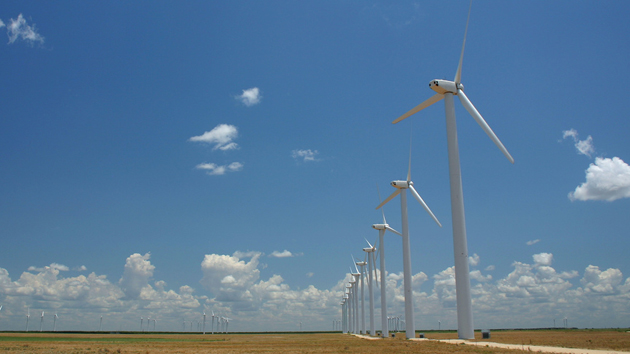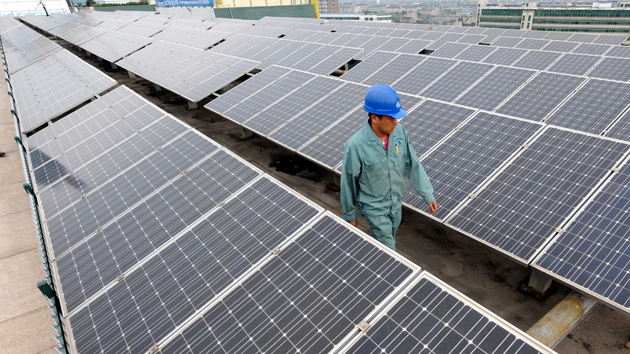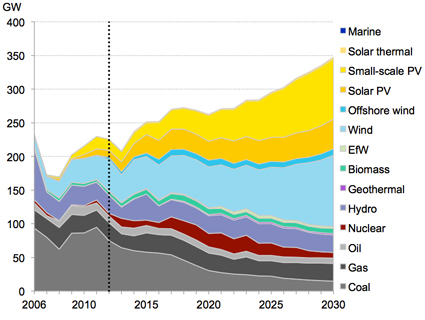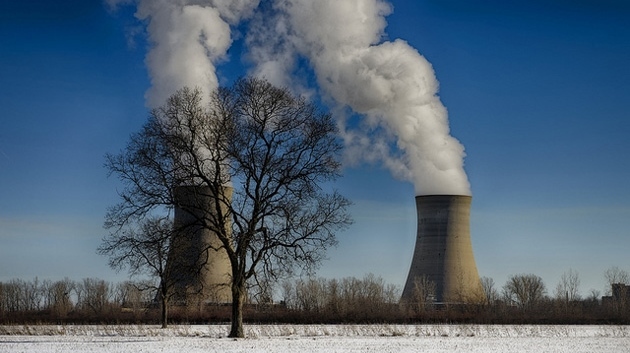
A nuclear power plant south of Detroit, Mich.<a href="https://www.flickr.com/photos/memoriesbymike/8456565270/in/photolist-dTh7eu-tBtwFE-6F7aGu-hvi8CV-epDWU-7ZiNTt-bD8hKH-bvMtU2-5F3hrk-6zwWoo-q52D8-fBCn8F-6nDAMR-8y29EZ-5UYxAU-btAa7t-5Fneb1-7wJa5b-5LTgwq-8GuvLq-ajpZkY-ajpZjE-ajnc6T-ao25ga-Bbuz1-9w6Rs9-9NGp3p-9WZ84C-drRRtw-eowJdk-5GoNLA-9JvstH-d1swRS-9NG4oZ-bvMuWV-bvMwhn-bvMw7K-bvMv1R-5JtfTx-9NDCmM-9NGokq-6DeMXT-9NEwpU-bvMwmz-9NGabs-9NJKMw-9NC9uz-nSRaL9-63q3TA-aVWove">Mike Boening</a>/Flickr</div>
This story was first published by CityLab and is reproduced here as part of the Climate Desk collaboration.
Renewable energy has had a busy year. California and New York have adopted ambitious plans calling for 50 percent renewable energy by 2030. A group of Stanford and Berkeley scientists has put forth an even bolder vision—encouraging all 50 states to run on wind, water, and solar by 2050, without any nuclear energy or biofuels in the picture. New York City Mayor Bill de Blasio has announced his intention to go fully renewable with the city government’s power, too.
A world without any fossil fuel energy would be a much cleaner place for both people and the environment. Right now renewable energy accounts for just 13 percent of all US electricity. A significant increase in that share would lead to a major reduction in air pollution and its attendant diseases, not to mention the costs of climate change-induced flooding or wildfires. The lives, time, and property saved could be put to work tackling other social problems.
But it’s not entirely clear that a US energy grid based on 100 percent renewables is the best way to achieve a zero-carbon future. On the contrary, there’s a strong environmentalist case for approaching that goal with caution. Limiting a zero-carbon future to wind, water, and solar means greater costs of storing this energy, discarding other existing zero-carbon sources like nuclear, and generally blanketing the earth with panels and turbines as a means to save it.
The merits of total transformation
For their renewable energy roadmap study, Stanford professor Mark Jacobson and his team used US Energy Information Administration data to project “business as usual” energy consumption in 2050. They then compiled state-by-state energy portfolios needed to meet that projected demand demand through expanded wind, water, and solar energy generation.
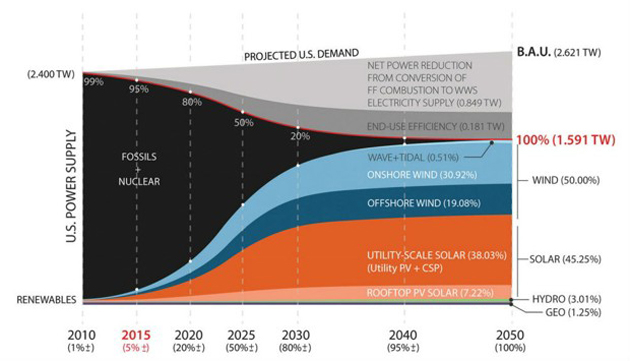
The endpoint is a future in which every driver in America rides an electric car, every stove in every house and restaurant cooks with electricity instead of gas, every plane flies by cryogenic hydrogen (that’s what rockets use, and the Soviet Union built an experimental airplane that flew on it, too). The authors point out that electric energy is more efficient than fuel combustion for heating and motors. When that efficiency is scaled up to an entirely electrified society by 2050, they project a 39.3 percent reduction in America’s electricity load compared to business as usual.
Heavy reliance on wind (50 percent of supply) and solar (45.25 percent of supply) pose the challenge, though, of meeting peak consumer energy demand when the sun isn’t shining or the winds die down. Jacobson and company propose to do this without any new battery technology by assembling a host of creative energy storage devices, such as piping surplus energy as heat into the ground and pulling it up later for use, or using cheap off-peak electricity to make ice which then goes to work cooling buildings during high-demand periods. The roadmap says that by 2050 it can “match load without loss every 30 [seconds] for six years”; the authors have an auxiliary study to support this claim, although it hasn’t been released yet.
This all might sound overwhelmingly expensive, but the researchers counter that with macro-level accounting of the societal costs avoided by a fully renewable grid. They estimate the price tag for lives lost to fossil fuel-induced air pollution; eliminating that pollution, they find, would save up to $600 billion per year in 2050. They also estimate savings to the US from avoiding climate change-related damage, such as droughts, wildfires, floods, and severe weather. The shift to renewables will eliminate around 3.9 million jobs associated with the old energy industry, but will result in a net gain of around 2 million 40-year jobs.
Jacobson sees this transition as a way to recognize the negative externalities the country has already been paying for. “The people who are running these coal mines have not paid for the health and climate costs they’ve been causing,” he says. “They’ve been freeloading on society for a long time.”
The downsides of monoculture
The goal of 100 percent renewables plans is to achieve a host of social benefits by cutting carbon emissions out of energy production. Rejecting some zero-carbon energy sources, such as nuclear, from the outset makes the problem harder, says MIT doctoral candidate Jesse Jenkins, who researches the electric power sector’s transition to a zero-carbon system.
“Why would we want to constrain ourselves to a narrow set of options to confront climate change and air pollution and other energy sector challenges when those challenges are already quite difficult?” he says.
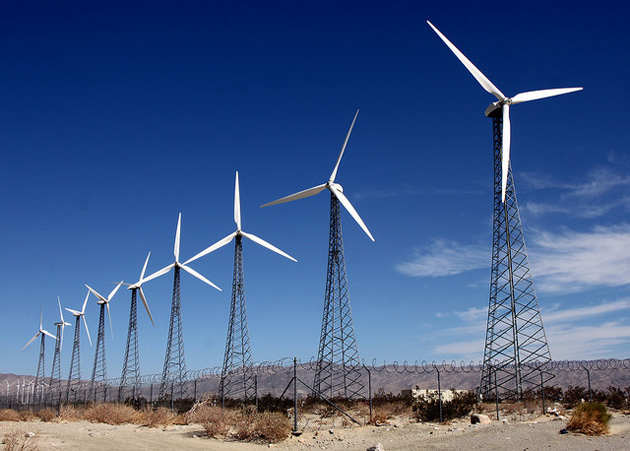
An entirely renewable portfolio creates its own special obstacles. For instance, Jenkins notes, the marginal value of renewables decreases as they penetrate the market. The free energy inputs of wind and solar initially displace the more expensive energy inputs, like natural gas. But assuming renewables successfully displace all coal and natural gas, then the plan would require building more wind and solar in order to displace nuclear, which provided 19 percent of US electricity production in 2014. That requires spending more money to achieve the same goal of a clean grid.
The other problem for planning an all-renewable grid is variability: solar produces when there is enough sun and wind produces when there is enough wind. Luckily the sun tends to shine during the day, when there’s higher demand for energy. But to ensure power when the renewables aren’t producing much requires energy storage. That storage could be done through batteries, or the heat, ice, and other methods Jacobson mentions.
“What people really miss about storage is it’s not just a daily storage problem,” says Armond Cohen, executive director of the Clean Air Task Force, a group that researches low-carbon energy technologies. “Wind and solar availability around the world, from week to week and month to month, can vary up to a factor of five or six.”
Storage has to account for when the wind cuts out for weeks due to seasonal weather variation. It’s easy enough to make ice one night to cool your building the next day, Cohen notes, but to save energy for three weeks of low wind you would need to store up enough ice to cool the building for that whole time.
Accounting for sufficient storage, then, increases the costs and scope of the energy transition. Jacobson calls for 605,400 megawatts of new storage capacity. US grid storage as of August 2013 totaled 24,600 megawatts, meaning a nearly 25-fold increase would be required to meet the roadmap. That’s not impossible, but it’s an effort that would not be necessary with continuous energy sources.
The other zero-carbon energy: nuclear
Plans calling for 100 percent renewable energy eliminate nuclear energy from the mix. The new state roadmap casts out nuclear without much discussion, but Jacobson tells CityLab this is because when you factor in the mining and refining of uranium, nuclear energy emits more carbon than wind power. He also cites the difficulty and expense of creating new nuclear plants, and other risks like proliferation and meltdown.
The decision to entirely abandon nuclear was particularly galling to Michael Shellenberger, president and co-founder of the Breakthrough Institute, which researches ways that modernism and technology can improve human prosperity and safeguard the environment, and an author of An Ecomodernist Manifesto. He argues that nuclear’s efficiency, small land-use footprint, and limited resultant pollution make it a vital part of any low-carbon future.
“If you care about the environment, you want food and energy production to become more efficient and centralized,” he says. “You want to put less inputs in and get more outputs out and get less waste.”
As primary energy sources advanced from firewood to coal to natural gas to nuclear, Shellenberger says, humans have managed to get consecutively more energy out compared to what they put in. “Neither solar nor wind are actually substitutes for coal or natural gas or oil,” he says. “The new product has to be equal to or superior than the predecessor and solar and wind are totally different than those fuels and inferior in that they’re intermittent.”
Stanford economics professor Frank Wolak, director of the Program on Energy and Sustainable Development, agrees that nuclear should play a role in a zero-carbon grid. He notes that American nuclear generators are safer than ever and have an extremely high capacity factor, meaning they produce almost all of their potential energy. American nuclear set a record high capacity factor of 91.8 percent for 2014. Wind and solar have capacity factors less than half as large.
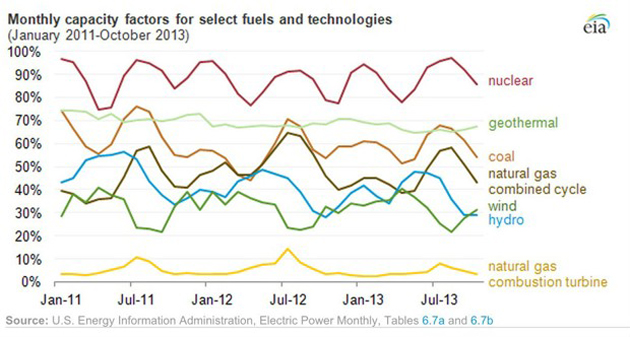
“Nuclear energy is an extremely reliable source of zero-carbon energy,” Wolak writes via email. “It makes very little economic sense to phase it out, particularly given how successful the US nuclear industry has been over the past 30 years.”
The irony of environmentalists cutting out nuclear in favor of primarily wind and solar is that these sources require much more transformation of the landscape to produce the same amount of energy. That footprint draws opposition from other environmental groups and people who just don’t want to live near wind turbines.
The Jacobson plan, for instance, envisions 156,200 new five-megawatt offshore wind turbines. Cohen from the Clean Air Task Force compares that to the Cape Wind project, which would have installed 468 megawatts of wind turbines off Cape Cod. That project collapsed following legal and political opposition from millionaire landowners, but also local townspeople and fishermen. Jacobson’s proposal amounts to building nearly 1,700 times the offshore capacity of Cape Wind.
A diverse portfolio
The Jacobson roadmap shows that a 100 percent renewable grid is feasible from an engineering standpoint. The politics of implementing such a plan are much trickier, though. The study itself offers only broad recommendations for easing the transition (e.g. “Incentivize more use of efficient lighting in buildings and on city streets.”), and points to the ramp-up of aircraft production during World War II as evidence of America’s manufacturing ability under pressure.
Whether or not US urgency about the environment will ever reach wartime heights is another question. Jacobson says it will be up to policymakers to fill in the details, and notes that the recent renewable visions outlined by California and New York show it can be done. “We’re trying to provide an endpoint and each state is going to have to figure out how to get to that endpoint,” he says.
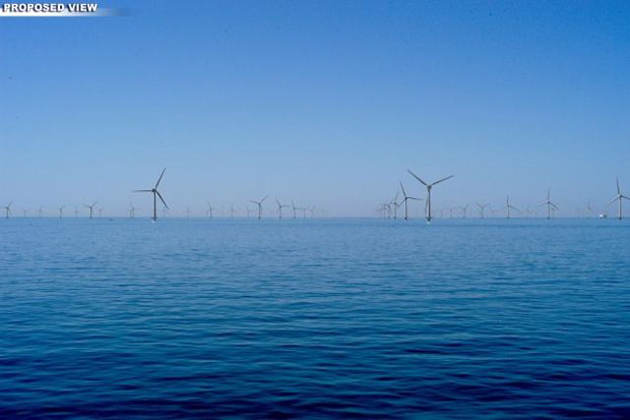
Technical and political feasibility aside, it’s also unclear why a fully renewable grid would be more desirable than any other combination of zero-carbon energy sources. “[The 100 percent renewable roadmap] is not an optimization study,” says Jenkins. “It’s not saying this is the best pathway forward in terms of any metric, particularly in terms of cost. They say, ‘How much can we push renewables and only renewables? And what will be necessary to try to decarbonize with that pathway alone?'”
In other words, if the goal is to cut out carbon emissions, there are other ways to do it. Jenkins is working on models that optimize the electric grid with constraints for cost, technical feasibility, and low CO2 emissions. For an area with Texas-like wind and solar resources and energy demand, around 67 percent would come from nuclear (plus hydropower or fossil fuels with carbon capture and storage if available). Wind and solar make up about 19 percent, and the remaining 13 percent would be gas utilities that fire up quickly to meet peak demand when the other sources can’t. Those numbers change for different places, and in a scenario with better storage capacity, renewables can take on more of the load from nuclear.
“All these pieces work together,” Jenkins says. “If you try to push any one of these pieces too far it ends up being more costly and difficult to manage than the optimal system.”
As solar and wind technology improves and gets cheaper, other paths to cleaner power are evolving, too. New molten salt nuclear reactors, still in development, promise less uranium-intensive power generation that doesn’t need water for cooling. They would play a significant role in bringing costs down for nuclear plants. Technology to retrofit fossil fuel plants for carbon capture and storage is still scaling up and lowering costs, Jenkins says. That would make it possible to clean up coal and gas plants that still have decades of operation left in their lifetimes, rather than shutting them down and building new capacity in their place.
There’s a good environmental argument for replacing dirty fossil fuel systems with renewables, but the reasons for replacing zero-carbon systems with other zero-carbon systems are less clear. Recognizing cost constraints while planning for a zero-carbon grid would force us to do more with less, which is actually a pretty good approach to sustainability.
